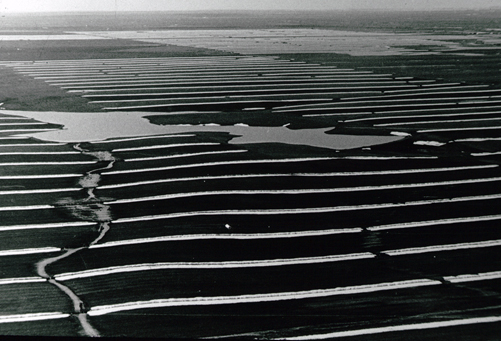Not the least of the adversities the Corps of Discovery faced was the relentless wind of vast region that later came to be known as the Great Plains, which extended from the tall-grass prairie of central Illinois to the Red River of the North, through the mid-grass prairie of the Dakotas, and the short-grass prairie of the eastern two-thirds of Montana. The journalists mentioned it again and again, usually in frustration and resignation, sometimes with tongue-in-cheek good humor, and at least once with some scientific objectivity.
On 4 June 1805, while they were exploring the “north branch” which he would soon name Maria’s River, Lewis and his men camped “among the willow bushes which defended us from the wind which blew hard from the N. W.”
We can be forgiven for reading a quality of relief into Lewis’s words, for similarly, during the first two decades of the 20th century, homesteaders on the plains planted trees to shield their homes and barnyards from strong wind and blowing snow. Shelterbelts, as they are called, are not only practical conveniences but psychological necessities. The South Dakota pioneers in Ole Edward Rolvaag’s novel, Giants in the Earth, dealt stoically with fickle weather, but it was the wind that drove one of them to insanity.
At the town of Cut Bank, in the heart of the Golden Triangle, near which Lewis and company camped on 21 July 1806, recent records indicate that, on average, the wind is calm less than one percent of the time, averaging about 13 miles per hour, and occasionally reaching 75 to 100 mph in wintertime.
Native tree species such as willow, white ash, and box elder were sometimes used for shelterbelts, but they require plenty of water. The best choice was shrubby tree, the Siberian peatree or caragana (Caragana arborescens), which was imported as a windbreak in the Colonies during the 18th century. It grows to a height of 12 to 14 feet, has dense foliage, a small thirst, and tolerates extreme temperatures and high winds, characteristics that made it ideal for shelterbelts on the high plains in northeastern Montana.
Experience the Lewis and Clark Trail
The Lewis and Clark Trail Experience—our sister site at lewisandclark.travel—connects the world to people and places on the Lewis and Clark Trail.
Discover More
- The Lewis and Clark Expedition: Day by Day by Gary E. Moulton (University of Nebraska Press, 2018). The story in prose, 14 May 1804–23 September 1806.
- The Lewis and Clark Journals: An American Epic of Discovery (abridged) by Gary E. Moulton (University of Nebraska Press, 2003). Selected journal excerpts, 14 May 1804–23 September 1806.
- The Lewis and Clark Journals. by Gary E. Moulton (University of Nebraska Press, 1983–2001). The complete story in 13 volumes.



